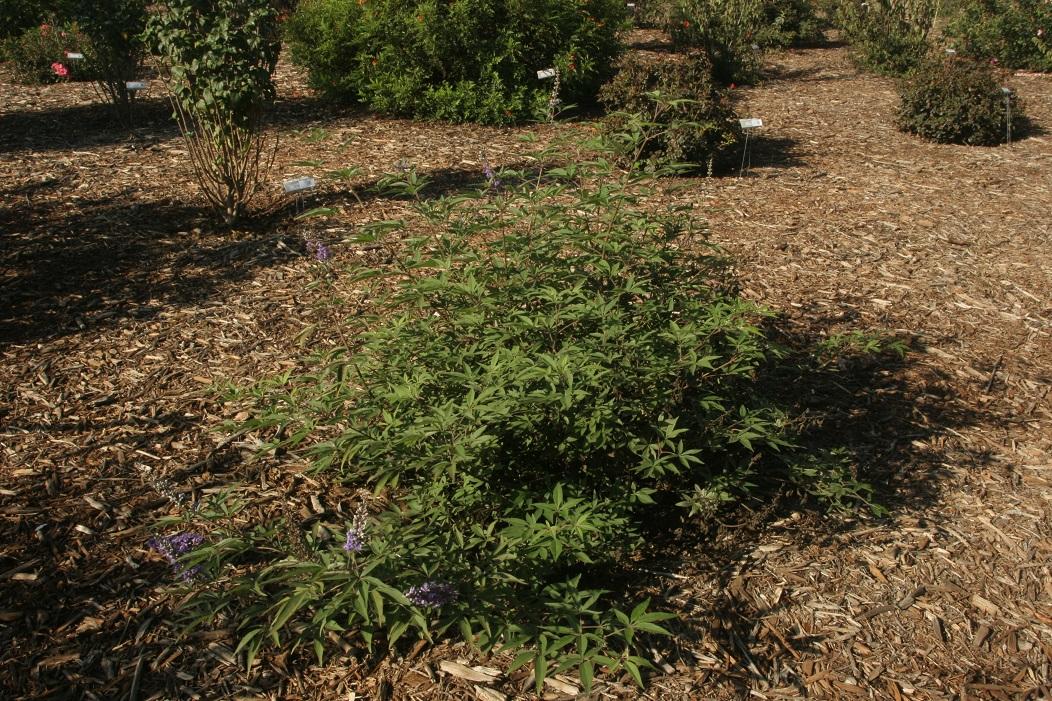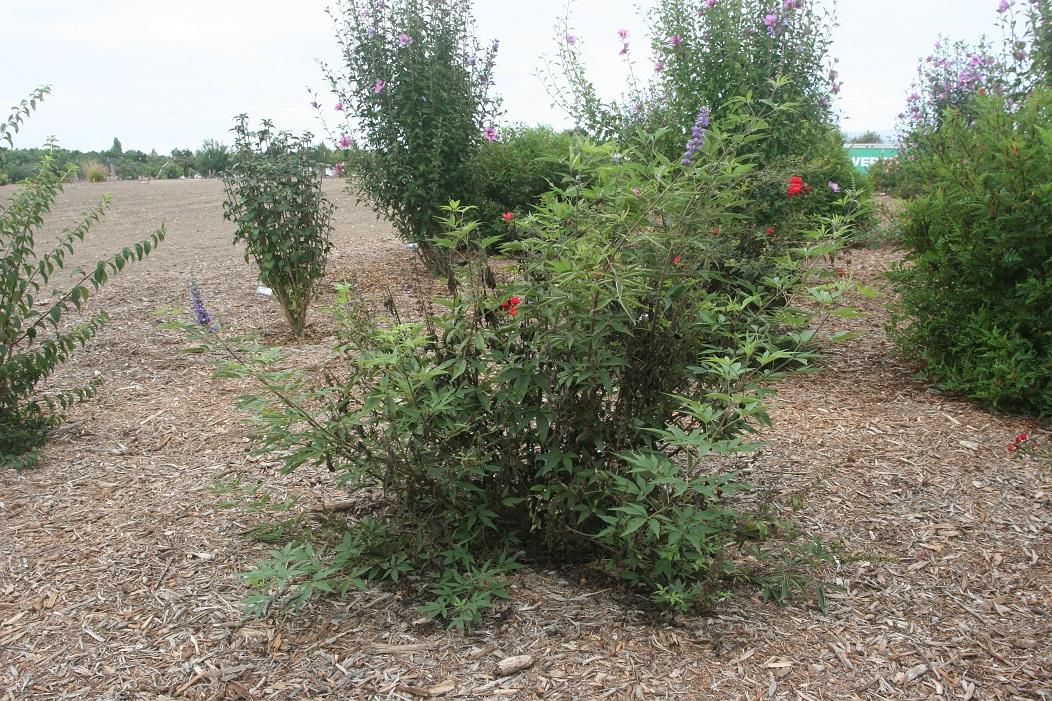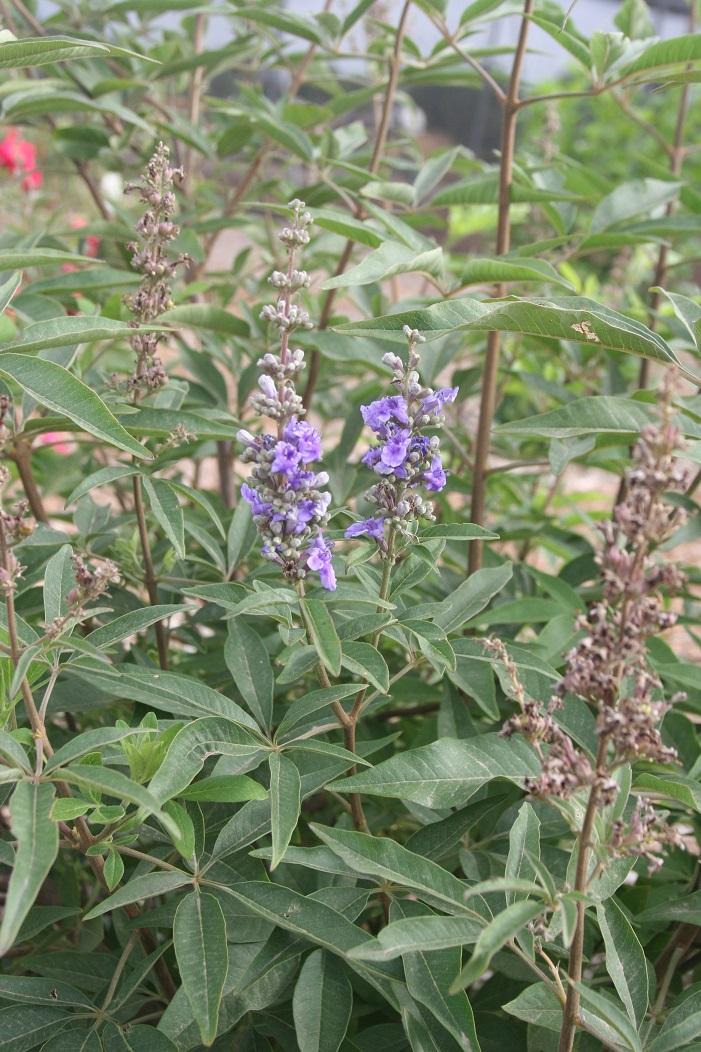Vitex agnus-castus 'SMVACBD'
Vitex agnus-castus 'SMVACBD' Blue Diddley® on low water in June 2022 at UC Davis. Photo: SK Reid.
Summary
South Coast Research & Extension Center (South Coast REC/SCREC) is located in Irvine California, this site has a sandy loam soil and plants are irrigated with reclaimed water. UC Davis is located in Davis, California, this site has a silty clay loam soil and plants are irrigated with potable water. More information about the field sites is located in the Nuts & Bolts section.
Blue Diddley is marketed as a compact cultivar of Vitex agnus-castus and during our two years of growing this cultivar it was less than 3’ tall and 4’ wide. Blue Diddley has bright green palmate leaves, with lighter green new growth, and terminal spikes of light violet flowers. During the establishment season we observed stems on some plants would die back to the ground and we were unable to ascertain the reason. Initially we were concerned this was a pathological response caused by a water mold. When this condition persisted the following year, we collected stomatal conductance measurements using a LiCor LI-600 porometer. After analyzing the data, colleagues at the University of Washington observed that Blue Diddley tended to leave its pores open during hot weather, which could lead to desiccation and be a cause or contributing factor to branch death. So, while we are unsure of the cause of occasional branch dieback, the plants themselves are not dying and they tend to re-sprout from the base.
Unfortunately, this branch dieback resulted in non-uniform appearance, and as a result this weighed down the overall appearance scores of those specimens. Another detrimental appearance factor was the relative lack of flowers as a counterbalance to non-uniformity. For the 80% and 50% treatments only 4 of 8 individuals on each treatment bloomed at all during the deficit season. The 20% treatment fared better with 6 of 7 plants blooming at least once during the deficit season. The 20% treatment was also the only treatment to have a seasonal average mean overall appearance score greater than 3. As a result, we would recommend Blue Diddley be classified as WUCOLS Low category in Region 2.
Blue Diddley has bright green palmate leaves, with lighter green new growth, and terminal spikes of light violet flowers. Blue Diddley is marketed as a compact cultivar and is part of the recent trend to develop shorter, more compact selections of Vitex agnus-castus. Blue Diddley was evaluated at UC Davis and South Coast REC (SCREC) with site specific performance details and recommendations below.
UC Davis Trial – Davis, CA
True to its marketing, Blue Diddley remained compact - after two years of growing, this cultivar was less than 3’ tall and 4’ wide. During the establishment season we observed stems on some plants would die back to the ground and we were unable to ascertain the reason. Initially we were concerned this was a pathological response caused by a water mold. During the deficit season we collected stomatal conductance measurements using a LiCor LI-600 porometer. After analyzing the data, colleagues at the University of Washington observed that Blue Diddley tended to leave its pores open during hot weather, which could lead to desiccation and be a contributing factor to branch death. So, while we are unsure of the cause of occasional branch dieback, the plants themselves did not die, and they tended to re-sprout from the base.
Unfortunately, this branch dieback resulted in non-uniform appearance, and this weighed down the overall appearance scores of those specimens. Another detrimental appearance factor was the relative lack of flowers as a counterbalance to non-uniformity. For the 80% and 50% treatments only 4 of 8 individuals on each treatment bloomed at all during the deficit season. The 20% treatment fared better with 6 of 7 plants blooming at least once during the deficit season. The 20% treatment was also the only treatment to have a seasonal average mean overall appearance score greater than 3. As a result, we would recommend Blue Diddley be classified as WUCOLS Low category in Region 2.
South Coast REC – Irvine, CA
Blue Diddley had a long bloom period, April to October, but plants were not heavy bloomers – typically only a few plants on each treatment were blooming during data collection. Overall, the plants looked best at the start of the season in April and a gradual decline was observed as the season progressed. When reviewing various rating categories, this could be attributed to foliage quality and low vigor scores. Since this cultivar was not very floriferous, foliage quality was very important to overall aesthetics. Unfortunately, its leaves often showed signs of insect damage, necrosis, and rust was observed. Lower than acceptable ratings were also due to the lack of uniformity observed in cultivar. With no significant differences between treatments, we recommend Blue Diddley given a Low water rating in WUCOLS Region 3.
Basic Info
| Submitted by: | Spring Meadow Nursery |
| Site(s): | UC Davis & SCREC |
| Trial Exposure: | Sun |
| Year evaluated: | 2022 |
| Height & Width after 2 years: | 2.7-3.9' x 2.2-3.25' - UC Davis 4.9-5.3’ x 3-3.9’ - SCREC |
| Reported Height & Width at maturity: | 3-6' x 3-6' |
| WUCOLS plant type: | S |
| Water Needs & WUCOLS Region: | Low - Region 2 Low - Region 3 |
Mean Overall Appearance rating: (1-5 Scale, 5 is highest) | 3.3 - UC Davis 3.2 - SCREC |
| Flowering Months: | July-Sept. - UC Davis April-Oct. - SCREC |
Growth and Quality Data
Click Here for Complete Data Set - UC Davis
Click Here for Complete Data Set - SCREC

Vitex agnus-castus 'SMVACBD' Blue Diddley® on moderate water in October 2022 at South Coast REC.

Vitex agnus-castus 'SMVACBD' Blue Diddley® on low water in September 2022 at South Coast REC.

Close up of Vitex agnus-castus 'SMVACBD' Blue Diddley® on low water in June 2022.